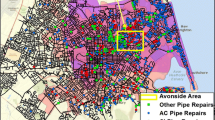Abstract
In this work ground failure following the 2010 Darfield earthquake in Canterbury, NZ was studied. Lateral spreading and horizontal ground strains were analyzed in an area near the Central Business District of Christchurch city. The Avon river runs through the middle of the study area and includes natural, filled and artificially cut stream bed stretches. Lateral displacement vectors from photogrammetric data were interpolated and used to produce ground strains. Large compressive and tensile strains were identified. Natural point bars were found to correlate closely with tensile strains. Natural stream bed (filled and existing) was found to closely correlate with compressive strains. Vector magnitude values of lateral displacements were found to correlate with water supply pipe repair rates (R2 = 0.42). However, ground strains did not correlate with lateral displacements, water supply pipe repair rates or settlements from the photogrammetric data. Therefore, it may be concluded that ground strains have limited use in the indication of potential repair rates and do not directly predict settlement. However, ground strains were observed as useful in identifying paleo-geomorphology of the area in general and changing soil density profiles in particular.





Similar content being viewed by others
References
Abdoun TH (1997) Modelling of seismically induced lateral spreading of multy-layered soil and its effect on pile foundations. PhD thesis, Troy, Rensselaer Polytechnic Institute, New York
Edinger J, Tang A (2011) Christchurch, New Zealand earthquake sequence of Mw 7.1 September 04, 2010, Mw 6.3 February 22, 2011, Mw 6.0 June 13, 2011: lifeline performance. s.l.: ASCE
Edinger J, Tang A, O’Rourke T (2010) Report of the 4 September 2010 Mw 7.1 Canterbury (Darfield), New Zealand earthquake. Technical Council on Lifeline Earthquake Engineering (TCLEE). s.l.: ASCE
ESRI (2010) The ArcGIS desktop 9.3 help. Environmental Systems Research Institute, Inc., Redlands. Available from http://webhelp.esri.com
Forsyth P, Barrell D, Jongens R (2008) Geology of the Christchurch Area. Institute of Geological and Nuclear Sciences GNS Science 1:250,000 Geological Map 16, p 67
Green R, Cubrinovski M (2010) Geotechnical reconnaissance of the 2010 Darfield (New Zealand) earthquake. Geotechnical Extreme Events Reconnaissance (GEER)
Hamada M, O’Rourke T (eds) (1992) Case studies of liquefaction and lifeline performance during past earthquakes, vol 1, 3. Technical report NCEER-92-0001. National Centre for Earthquake Engineering Research, Buffalo
Meyersogn WD (1994) Pile response to liquefaction-induced lateral spread. PhD thesis, s.l.: Cornell University
Milashuk S (2010) Taylor approximation—asolution for round-off problems when modeling LINAC accelerating cavity. ERL reports—2010. Cornell University. Available from http://www.lns.cornell.edu/public/ERL/2010/ERL10-2/ERL10-2.pdf
Milashuk S, Crane WA (2011) Wind speed prediction accuracy and expected errors of RANS equations in low relief inland terrain for wind resource assessment purposes. Environ Model Softw 26(4):e429–e433
National Research Council (1985) Liquefaction of soils during earthquakes. Report no. CETS-EE-001. Committee on Earthquake Engineering. National Academy Press, Washington
Sano Y (1998) GIS evaluation of Northridge earthquake ground deformation and water supply damage. M.S. thesis, s.l.: Cornell University
Tonkin & Taylor Ltd (2011) Canterbury earthquake sequence 4 September 2010 to 13 June 2011. s.l.: Canterbury Earthquake Recovery Authority. Available from http://url.ie/f49k
USGS (2011) NEIC: earthquake search results. http://neic.usgs.gov. Available from http://url.ie/dziw
Van Dissen R, Barrell D, Litchfield N, Villamor P, Quigley M, King A, Furlong K, Begg J, Townsend D, Mackenzie H, Stahl T, Noble D, Duffy B, Bilderback E, Claridge J, Klahn A, Jongens R, Cox S, Langridge R, Ries W, Dhakal R, Smith A, Horblow S, Nicol R, Pedley K, Henham H, Hunter R, Zajac A, Mote T (2011) Surface rupture displacement on the Greendale Fault during the Mw 7.1 Darfield (Canterbury) earthquake, New Zealand, and its impact on man-made structures. Building an Earthquake-Resilient Society 14-15 April, 2011, Auckland, New Zealand. s.l.: In: Proceedings of the ninth Pacific conference on earthquake engineering
Author information
Authors and Affiliations
Corresponding author
Rights and permissions
About this article
Cite this article
Milashuk, S., Crane, W. Ground Movement and Strains from Airphoto Measurements in Avonside Caused by 2010 Darfield Earthquake. Geotech Geol Eng 30, 1045–1051 (2012). https://doi.org/10.1007/s10706-012-9509-2
Received:
Accepted:
Published:
Issue Date:
DOI: https://doi.org/10.1007/s10706-012-9509-2




